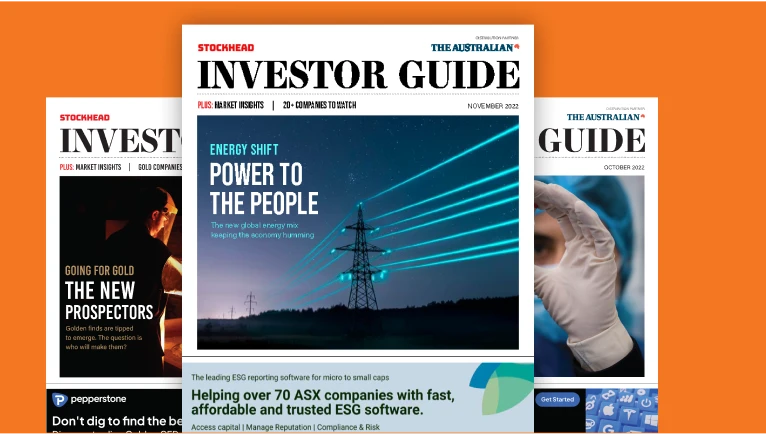The world’s going mad for copper – but tin has just as much going for it

Tin explorers are starting to capture attention. Pic: Getty Images
- It flies under the radar, but tin could be the best metal to play the electrification narrative
- Supply is dominated by unstable jurisdictions like Myanmar, Indonesia and the DRC
- Rising tin prices are providing support for explorer like Caspin and Stellar Resources
Supply disruptions have copper chasing record highs again, with an emerging 600,000t shortfall on copper expected from the Grasberg mine in Indonesia and a 60,000t cut at Teck’s Quebrada Blanca in Chile highlighting again the delicate balance for the red metal, key in electrification and modern technology.
But dig beneath the surface and Dr Copper is not the only ailing patient out there with a need for higher prices to cure what ails it.
Over the past six months two key incidents have highlighted the tenuous state of primary tin supply, first the temporary shuttering of the high grade Bisie mine in the DRC as Rwandan-backed M23 rebels took control of the minerals rich North Kivu province.
That supply fear abated, only for the Indonesian Government to move on over 1000 ‘illegal’ tin mines in the country, where alluvial production accounts for more than a quarter of the world’s tin.
Some aspects of that move are about restructuring rather than restricting the Indonesian tin market. Prabowo Subianto’s Government later announced six unofficial smelters would be traded to state-sponsored miner PT Timah.
According to Fastmarkets, the Indonesian Government thinks the seizure of illegal mining operations in the Bangka Belitung region will save the State US$1.2bn in the next three months and US$2.6bn by end 2026.
Prices which pounded on the door of US$38,000/t are now back to US$36,396/t on the LME.
But those are super high by historical standards, and with supply effectively stagnating at 370,000t, deficits for the metal predominately used to solder electronic circuitboards are expected to grow as demand doubles in the coming two decades.
“Everybody understands how important copper is and tin has got an equally important role in electrification. It’s the unsung hero of the electrification thematic,” said Greg Miles, the boss of ASX tin explorer Caspin Resources (ASX:CPN).
Previously a nickel and PGE hunter, Caspin shifted its focus radically last year after acquiring the established Bygoo project in New South Wales.
“You need copper to wire everything together, but then you need tin in solder to glue it all together,” Miles said.
“The short, medium and long-term thematic for tin is fantastic so i’m surprised that people aren’t looking for tin assets more readily but i think that’ll change.“
Bygoo days
Bygoo is located in the NSW Riverina, near the town of Ardlethan, which proudly describes itself as the home of the kelpie, Australia’s iconic breed of working dog.
Ardlethan, which is excised from the Bygoo package, produced some 48,000t of tin until 1986.
The surround Bygoo, which sits on a belt scale land holding over 1180km2, has seen the definition of seven tin prospects up to its acquisition by Caspin, but exploration over the past 40 years has been limited.
That included 30 years without a single drill hole after the International Tin Council collapse in the 1980s.
Now, Bygoo is seeing its time in the sun.
Using a cut off of 0.15% Sn, Caspin has announced a maiden resource estimate of 3.94Mt at 0.5% Sn for 19,300t of contained tin metal.
Beyond that is an exploration target of far greater magnitude – 12-20Mt at 0.35-0.5% Sn, with extensions over 1000m of strike at the Kelpie deposit demonstrating the potential to double the maiden resource there.
And Kelpie represents just 5% of 20km of prospective granite horizon at the project, virtually none of which has been drilled.
“To try and demonstrate the scale of the project, we released a JORC exploration target at the same time (as the resource). And that was based on our understanding of the geology of the area, and the fact that tin mineralisation is strongly controlled by the contact of the Ardlethan granite with the overlying volcanic sediments,” Miles said.
“We’ve been able to trace that over 1000m and there’s nothing to suggest that the whole contact area isn’t mineralised.”
The main thing now is getting out and drilling, Miles said.
One big advantage is the project’s location in regional New South Wales. Most tin supply comes from locations like Indonesia, Myanmar and the DRC, alongside China.
Being able to source material from a stable, Western jurisdiction is a big deal. Australia’s only tin producer currently is the Renison mine in Tasmania half-owned by ASX lister Metals X (ASX:MLX), which supplies around 4% of the world’s primary tin metal.
Caspin has a one-two punch of sorts, diversifying also with the acquisition of the nearby Weethalle gold project. Can tin be the golden ticket?
“We’ve had a great run over the last month or so but there’s still plenty of value to be had so you know I’m glad that it’s finally being recognised but there is still a long way to go,” Miles said.
“We think that we’re a much bigger company than what we are today. We’re trying to be two or three or four times bigger than that in the next sort of 12 to 18 months.”
Stellar opportunity
On Tasmania’s west coast, near the historic mining town of Zeehan, another contender is already further along in its bid to become Australia’s second tin producer.
Stellar Resources (ASX:SRZ) has reinvigorated itself under new management, with former chair Simon Taylor, who previously sold West African gold explorer Oklo Resources to mid-tier B2 Gold, stepping into the MD’s chair last year.
Known dealmaker Mark Connelly joined as chair, with fellow Oklo and Pappilon man Andrew Bird entering as executive director.
That has shone a bright light on the company’s key asset, the Heemskirk tin project, which at close to 7.5Mt an over 1% tin, is the highest grade undeveloped deposit in Australia and third highest in the world.
A scoping study last year demonstrated that the mine would generate strong free cash flows at prices of just US$28,000/t.
LME tin hasn’t breached that level since the start of 2025, and with anticipated all in sustaining costs in the US$18,000/t range, Heemskirk would be making a 100% AISC margin at today’s price levels, similar to many gold producers in the current bull market.
Located in one of Australia’s top historic mining centres, latent infrastructure nearby could smooth a pathway to production. Stellar recently signed a MoU to assess whether it could retool the mothballed Avebury nickel plant to process cassiterite ore.
With a market cap of around $70m, Stellar’s shares are up 55% YTD. Taylor says Heemskirk is more advanced than many punters realise.
“We’ve got a larger resource than Renison had in reserves in 1968 (when it opened) so we see our project as having a lot of upside,” Taylor told Stockhead.
“We think it’s going to develop into a much bigger resource in time with drilling and excited about pushing our PFS to that 8 to 10 year mine life.”
Heemskirk sits in similar geology to Renison, featuring the same Devonian granites. But while Metals X is now mining at 1.2-1.3km deep, the current Heemskirk resource extends to just 500-600m.
“The grade is good and we’re finding with our deeper drilling the grade is increasing, which is a big plus,” Taylor said.
“We’re down about 500, 600 metres now with our resource.
“What we also like about that is that we’ve got the same geology driving our deposit, the same Devonian granites that are sitting 1.2-1.3km below our deposits.
“There’s lots of room to continue to grow our resource at depth once we get into production.”
The same geological model is being investigated at a host of regional targets, including East Renison and the newly acquired Granite Tor project.
Taylor also thinks Stellar is in a good position when it comes to securing funding and customers for the future Heemskirk development, with its offtake unencumbered in a sector seeing increasing corporate activity.
That includes the acquisition of the majority stake in Alphamin, the company that owns the Bisie operation, to an Abu Dhabi backed investor, as well as China’s Xingye’s purchase of Moroccan developer Atlantic Tin.
At Stockhead, we tell it like it is. While Caspin Resources and Stellar Resources are Stockhead advertisers they did not sponsor this article.
Related Topics

UNLOCK INSIGHTS
Discover the untold stories of emerging ASX stocks.
Daily news and expert analysis, it's free to subscribe.
By proceeding, you confirm you understand that we handle personal information in accordance with our Privacy Policy.








